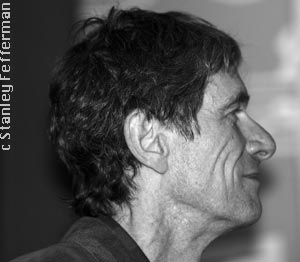
|
Michel Gonneville & Protégés
presented by New Music Concerts |
|
| March 7, 2008 • Glenn Gould Studio • Toronto |
|
|
|
|
|
|
| Report & photos by Stanley Fefferman |
| Michel Gonneville’s students regard him as an exceptionally open-minded teacher. He encourages them to be more themselves, to be rigorous in shaping their work, and he promotes them to ensembles and patrons.
Gonneville is grateful to his students. They are his teachers: they teach him that “music can be made out of anything.”
Each of the young composers made music out of unique sonic materials. While several of them are political by inclination or implication, Nicholas Gilbert tries “to forget about the world.” He composes because he is a composer, not because he has beliefs. His “Réflections circulaire…etc” for two violins, a prelude to Gonneville’s string quartet, is ethereal, lyrical, remarkable for glissandos, drones and dynamic rhythms like the tracks of an airborne insect.
|
| Frans Ben Callado, feels under attack by the sellers of ‘art’, writes music he describes as ‘an outcry’. His “Black Boxes, Op.30 (2008)” draws title and sonic inspiration from air disasters. Performed by a nine person ensemble of brass, winds, strings and percussion, it is vivid, spacey music with a big sound, lots of ideas, including the sounds of explosions and gunfire. Very exciting music.
Charles-Antoine Fréchette wrote his “Pureté violée” as a commentary on the contemporary ‘rape of silence’. Inspired also by an actual victim of abuse, the piece relies on winds and percussion (prominently, a device made of pop bottles and empty beer cans) that sigh, rattle and clank, suggesting structures in a state of collapse.
|
|

Michel Gonneville |
|
| I thought of Oliver Sack’s, the neurologist who writes about ‘amusia’, the condition where brain damage can suppress the ability to recognize musical sounds, so that Mozart sounds like “pots and pans scraping across a tile floor.” But in this case, Fréchette makes what sounds like the scraping of pots and pans sound like very good music, fulfilling Gonneville’s discovery that “music can be made out of anything.”
Maxime McKinley’s “Wirkunst-Nijinski (2007)”, inspired by the great Russian dancer’s labyrinth-like notebook drawings, was the most kinetic piece of the evening, had a beat, called very interesting sounds out of David Hetherington’s cello, combined hammered church bell sounds with high pitched ref’s whistle and ended peacefully as a requiem.
André Ristic’s “Trigger-Partita (2008),” performed by himself on sampler with Robert Aitken on amplified flute was the most amusing piece in the concert. The flute was sometimes Debussyian, lyric, and sometimes technically extended to outer space. Against this, the sampler emitted burps, cricket chirps, chicken clucks, car horns, cartoon ‘boings’, gunfire, and human vocal ejaculations.
Benoit Coté’s “Pan-toutt (2007)”, largely for brass and piano, is a lovely piece, solid and optimistic, as the composer himself appears to be, built up gradually and surely with bold strokes and patches of musical colour applied to a broad canvas thickly with a pallette-knife.
The evening closed with the 21 piece New Music Ensemble and guests playing Gonneville’s “Le Cheminement de la baleine (1998).” The piece’s dedicatee Jean Laurendeau on the ondes Martenot and Max Christie on clarinet were the soloists. This music has a Bartokian complexity of texture, often undulates like waves of the whale sounds it celebrates, and imitates the celestial choir, vocal clamour, and high pitched panic associated with the mysterious outpourings of these profound creatures.
|
 |
| It would be wrong not to express some appreciation of the astonishing musicianship of the New Music Ensemble players who seem natively competent to harvest, year after year, the crop of new sounds brought to them by emerging composers. They are: Max Christie, Douglas Stewart, Keith Atkinson, Michele Verheul, Fraser Jackson, Michele Gagnon, Stuart Laughton, Ian Cowie, Scott Irvine, Rob Carli, Stephen Clarke, Rick Sacks, Trevor Tureski, Ryan Scott, Fujiko Imajishi, Carol Lynn Fujino, Douglas Perry, David Hetherington, Peter Pavlovsky and Robert Aitken (musical director). |
|
|
|
|
|
|
| Stanley Fefferman is a writer/photographer on the Toronto music scene and elsewhere. His work appears online at www.showtimemagazine.ca and here at The LMR. |
|
|



